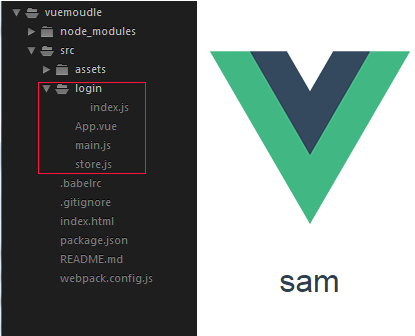【15】vuex2.0 之 modules
vue 使用的是單一狀態樹對整個應用的狀態進行管理,也就是說,應用中的所有狀態都放到store中,如果是一個大型應用,狀態非常多, store 就會非常龐大,不太好管理。這時vuex 提供了另外一種方式,可以把整個store 分成幾個大的模塊,如登錄模塊,用戶模塊等,每一個模塊都有自己的state, mutation, actions ,getters , 它就相當於是一個小的store,然後我們的根store(通過new Vuex.Store 生成的store) 通過它的modules屬性引入這些模塊,從而我們的組件就可以使用這些modules 中狀態(state).
新建一個項目體驗一下,通過vue –cli新建一個項目vuemodule, 不要忘記安裝vuex.
1, 在src 目錄下新一個login文件夾,在裏面新建index.js 用於存放login 模塊的狀態。 為了簡單起見,我把模塊下的state, actions,mutations, getters 全放在index.js文件中。
先簡單給它增加一個狀態,userName: “sam”

const state = {
useName: "sam"
};
const mutations = {
};
const actions = {
};
const getters = {
};
// 不要忘記把state, mutations等暴露出去。
export default {
state,
mutations,
actions,
getters
}
2,在src 目錄下,再新建一個 store.js 這是根store, 它通過modules 屬性引入 login模塊。

import Vue from "vue";
import Vuex from "Vuex";
Vue.use(Vuex);
// 引入login 模塊
import login from "./login"
export default new Vuex.Store({
// 通過modules屬性引入login 模塊。
modules: {
login: login
}
})

3, 在main.js中引入store, 並註入到vue 根實例中。

import Vue from ‘vue‘
import App from ‘./App.vue‘
// 引入store
import store from "./store"
new Vue({
el: ‘#app‘,
store, // 註入到根實例中。
render: h => h(App)
})

4,在 app.vue 中通過computed屬性獲取到login下的state. 這裏要註意,在沒有modules 的情況下,組件中通過 this.$store.state.屬性名 可以獲取到,但是有modules 之後,state 被限制到login 的命名空間(模塊)下,所以屬性名前面必須加模塊名(命名空間),組件中通過 this.$store.state.模塊名.屬性名,在這裏是 this.$store.state.login.userName

<template>
<div id="app">
<img src="./assets/logo.png">
<h1>{{useName}}</h1>
</div>
</template>
<script>
export default {
// computed屬性,從store 中獲取狀態state,不要忘記login命名空間。
computed: {
useName: function() {
return this.$store.state.login.useName
}
}
}
</script>

組件中成功獲取到狀態。項目目錄和展示如下

4 ,通過actions, mutations 改變名字, 這就涉及到dispatch action, commit mutations, mutations 改變state.
先在login 文件夾 index.js中添加changeName action 和 CHANGE_NAME mutations.

const mutations = {
CHANGE_NAME (state, anotherName) {
state.useName = anotherName;
}
};
const actions = {
changeName ({commit},anotherName) {
commit("CHANGE_NAME", anotherName)
}
};

在app.vue 中添加一個按鈕:<button> change to json</button>, 點擊時,dispatch 一個 action. 那在組件中怎麽dispatch actions 呢?
在模塊中,state 是被限制到模塊的命名空間下,需要命名空間才能訪問。 但actions 和mutations, 其實還有 getters 卻沒有被限制,在默認情況下,它們是註冊到全局命名空間下的,所謂的註冊到全局命名空間下,其實就是我們訪問它們的方式和原來沒有module 的時候是一樣的。比如沒有module 的時候,this.$store.dispatch(“actions”), 現在有了modules, actions 也寫在了module 下面(changeName 寫到了login目錄下的index.js中),我們仍然可以這麽寫,this.$store.dispatch(“changeName”), 組件中的getters, 也是通過 this.$store.getters.module中getters 來獲取。

<template>
<div id="app">
<img src="./assets/logo.png">
<h1>{{useName}}</h1>
<!-- 添加按鈕 -->
<div>
<button @click="changeName"> change to json</button>
</div>
</div>
</template>
<script>
export default {
// computed屬性,從store 中獲取狀態state,不要忘記login命名空間。
computed: {
useName: function() {
return this.$store.state.login.useName
}
},
methods: {
// 和沒有modules的時候一樣,同樣的方式dispatch action
changeName() {
this.$store.dispatch("changeName", "Jason")
}
}
}

5, 局部參數
雖然dispatch action和 commit mutations 可以全局使用,但是寫在module 中的actions, mutations 和getters, 它們獲得的默認參數卻不是全局的,都是局部的,被限定在它們所在的模塊中的。比如mutations和getters 會獲得state 作為第一個默認參數,這個state參數,就是限定在mutations 和getters 所在模塊的state對象,login 文件夾下的mutations 和getters 只會獲取到當前index.js 中的 state 作為參數 。 actions 會獲得一個context 對象作為參數,這個context 對象就是當前module 的實例,module 相當於一個小store.
那麽怎樣才能獲取到根store 中的state 和 getters 呢? Vuex 提供了 rootState, rootGetters 作為module 中 getters 中默認參數, actions中context 對象,也會多了兩個屬性,context.getters, context. rootState, 這些全局的默認參數,都排在局部參數的後面。
我們在store.js中添加 state, getters:

export default new Vuex.Store({
// 通過modules屬性引入login 模塊。
modules: {
login: login
},
// 新增state, getters
state: {
job: "web"
},
getters: {
jobTitle (state){
return state.job + "developer"
}
}
})

login 目錄下的 index.js

const actions = {
// actions 中的context參數對象多了 rootState 參數
changeName ({commit, rootState},anotherName) {
if(rootState.job =="web") {
commit("CHANGE_NAME", anotherName)
}
}
};
const getters = {
// getters 獲取到 rootState, rootGetters 作為參數。
// rootState和 rootGetter參數順序不要寫反,一定是state在前,getter在後面,這是vuex的默認參數傳遞順序, 可以打印出來看一下。
localJobTitle (state,getters,rootState,rootGetters) {
console.log(rootState);
console.log(rootGetters);
return rootGetters.jobTitle + " aka " + rootState.job
}
};

app.vue 增加h2 展示 loacaJobTitle, 這個同時證明了getters 也是被註冊到全局中的。

<template>
<div id="app">
<img src="./assets/logo.png">
<h1>{{useName}}</h1>
<!-- 增加h2 展示 localJobTitle -->
<h2>{{localJobTitle}}</h2>
<!-- 添加按鈕 -->
<div>
<button @click="changeName"> change to json</button>
</div>
</div>
</template>
<script>
import {mapActions, mapState,mapGetters} from "vuex";
export default {
// computed屬性,從store 中獲取狀態state,不要忘記login命名空間。
computed: {
...mapState({
useName: state => state.login.useName
}),
// mapGeter 直接獲得全局註冊的getters
...mapGetters(["localJobTitle"])
},
methods: {
changeName() {
this.$store.dispatch("changeName", "Jason")
}
}
}
</script>

6, 其實actions, mutations, getters, 也可以限定在當前模塊的命名空間中。只要給我們的模塊加一個namespaced 屬性:

const state = {
useName: "sam"
};
const mutations = {
CHANGE_NAME (state, anotherName) {
state.useName = anotherName;
}
};
const actions = {
changeName ({commit, rootState},anotherName) {
if(rootState.job =="web") {
commit("CHANGE_NAME", anotherName)
}
},
alertName({state}) {
alert(state.useName)
}
};
const getters = {
localJobTitle (state,getters,rootState,rootGetters) {
return rootGetters.jobTitle + " aka " + rootState.job
}
};
// namespaced 屬性,限定命名空間
export default {
namespaced:true,
state,
mutations,
actions,
getters
}

當所有的actions, mutations, getters 都被限定到模塊的命名空間下,我們dispatch actions, commit mutations 都需要用到命名空間。如 dispacth("changeName"), 就要變成 dispatch("login/changeName"); getters.localJobTitle 就要變成 getters["login/localJobTitle"]
app.vue 如下:

<template>
<div id="app">
<img src="./assets/logo.png">
<h1 @click ="alertName">{{useName}}</h1>
<!-- 增加h2 展示 localJobTitle -->
<h2>{{localJobTitle}}</h2>
<!-- 添加按鈕 -->
<div>
<button @click="changeName"> change to json</button>
</div>
</div>
</template>
<script>
import {mapActions, mapState,mapGetters} from "vuex";
export default {
// computed屬性,從store 中獲取狀態state,不要忘記login命名空間。
computed: {
...mapState("login",{
useName: state => state.useName
}),
localJobTitle() {
return this.$store.getters["login/localJobTitle"]
}
},
methods: {
changeName() {
this.$store.dispatch("login/changeName", "Jason")
},
alertName() {
this.$store.dispatch("login/alertName")
}
}
}
</script>

有了命名空間之後,mapState, mapGetters, mapActions 函數也都有了一個參數,用於限定命名空間,每二個參數對象或數組中的屬性,都映射到了當前命名空間中。

<script>
import {mapActions, mapState,mapGetters} from "vuex";
export default {
computed: {
// 對象中的state 和數組中的localJobTitle 都是和login中的參數一一對應。
...mapState("login",{
useName: state => state.useName
}),
...mapGetters("login", ["localJobTitle"])
},
methods: {
changeName() {
this.$store.dispatch("login/changeName", "Jason")
},
...mapActions(‘login‘, [‘alertName‘])
}
}
</script>

【15】vuex2.0 之 modules
